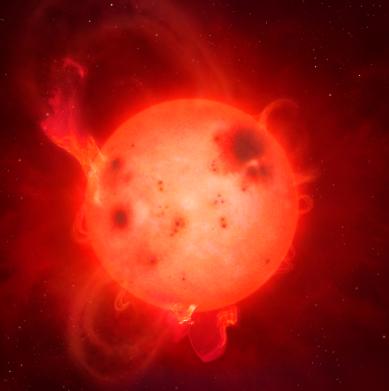Warwick: White Light Superflare on L Dwarf Star
Posted: Wed Apr 17, 2019 2:28 pm
Explosion on Jupiter-Sized Star Ten Times
More Powerful Than Ever Seen on Our Sun
University of Warwick | 2019 Apr 17
Detection of a Giant White-Light Flare on an L2.5 Dwarf with the Next Generation Transit Survey ~ James A. G. Jackman et al
More Powerful Than Ever Seen on Our Sun
University of Warwick | 2019 Apr 17
A stellar flare ten times more powerful than anything seen on our sun has burst from an ultracool star almost the same size as Jupiter.
The star is the coolest and smallest to give off a rare white-light superflare, and by some definitions could be too small be considered a star.
The discovery ... sheds light on the question of how small a star can be and still display flaring activity in its atmosphere. Flares are thought to be driven by a sudden release of magnetic energy generated in the star’s interior. This causes charged particles to heat plasma on the stellar surface, releasing vast amounts of optical, UV and X-ray radiation. ...
The L dwarf star located 250 light years away, named ULAS J224940.13-011236.9, is only a tenth of the radius of our own sun, almost the same size as Jupiter in our solar system. It was too faint for most telescopes to observe until the researchers, led by the University of Warwick, spotted the massive stellar explosion in its chromosphere in an optical survey of the surrounding stars.
Using the Next Generation Transit Survey (NGTS) facility at the European Southern Observatory’s Paranal Observatory, with additional data from the Two Micron All Sky Survey (2MASS) and Wide-field Infrared Survey Explorer (WISE), they observed the brightness of the star over 146 nights. ...
Detection of a Giant White-Light Flare on an L2.5 Dwarf with the Next Generation Transit Survey ~ James A. G. Jackman et al
- Monthly Notices of the RAS: Letters 485(1):L136 (May 2019) DOI: 10.1093/mnrasl/slz039
arXiv.org > astro-ph > arXiv:1902.00900 > 03 Feb 2019 (v1), 14 Mar 2019 (v2)
